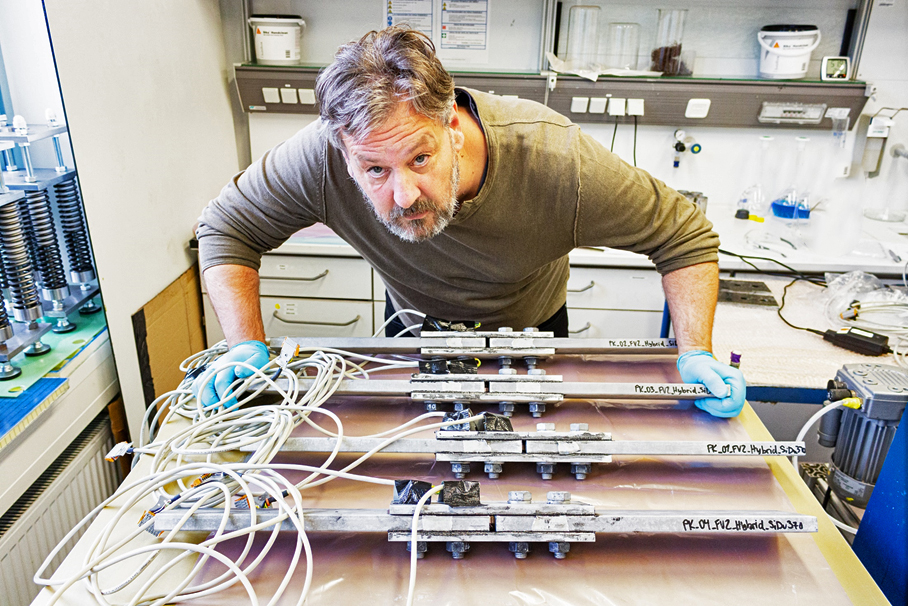Hybrid joints combine different joining technologies and are increasingly used in various industries. The decisive strength of a hybrid joint is that advantages of the elementary joining technologies are used and disadvantages are compensated.
In hybrid joints, adhesive bonding often results in increased joint stiffness, increased energy absorption capacity, and improved corrosion resistance. In hybrid joints, the mechanical joining method often results in immediate initial strength, compensation for changes in mechanical properties, an increase in peel strength and the extension of the service temperature range.
Adhesive bonding can be advantageously combined with various mechanical joining processes, depending on the application and industry. Fraunhofer IFAM develops solutions for various industries, for example for transportation, white goods, or construction.
Adhesive bonding in combination with the pre-tensioned screw connection
Adhesive bonding is becoming increasingly important as a joining technology for load-bearing connections in steel construction. Classic connections are usually screwed or welded. Pre-tensioned screw connections have the advantage of increased fatigue strength. The pretensioning causes a higher load-bearing capacity due to static friction of the substrates, which is, however, limited by the possible static friction coefficient.
Hybrid joints consisting of a pre-tensioned screw connection and adhesive bonding remove this limitation and allow the load-bearing capacity to be further increased. In the project "Pre-tensioned hybrid joints", Fraunhofer IFAM, together with Fraunhofer IGP, has investigated how the joint use of adhesive bonding and pre-tensioned screw connections can add value for steel construction.
Direct benefits - also for small and medium-sized enterprises
The work of by Fraunhofer IFAM enables the establishment of norms and standards for steel and rail vehicle construction. The utilization of the results for the combination of pre-tensioned screw connection and adhesive bonding as a hybrid connection for typical component surfaces, component materials, and sheet thicknesses also increases the competing power of small and medium-sized enterprises (SMEs). In particular for the construction industry, where SMEs such as steel construction and assembly companies as well as engineering offices are usually active, but also regarding the supplier industry of rail vehicle construction, there is great innovation potential here.
The investigations have shown that the higher load-bearing strength as well as the lower deformations of the hybrid connection have been verified. Fraunhofer IFAM has shown that the connections can be designed by a probabilistic verification.
Hybrid joining of sheet metal: Fabrication, testing and simulation
Mechanical joining or welding in combination with adhesive bonding is used very frequently for hybrid joining of thin-walled sheet metal components in the automotive industry and, among others, white goods. Weld bonding, rivet bonding or clinch bonding are used to join the car bodies of many German vehicle manufacturers. In the field of car doors, hemm bonding is very common. Despite the high potential of these hybrid joining processes and their frequent industrial application, many technological problems still occur in production and end properties.
Fraunhofer IFAM has shown that problems such as leakage of adhesives, lack of strength, and corrosion problems often result from the interaction between the liquid adhesive and the secondary joining method during the joining process. Our experts have shown that processing properties of the adhesive and parameters of the secondary joining processes must be specifically matched to each other during the development phase and checked during production.
In particular, the flow behavior of the adhesives should be adjusted in advance and controlled in production by knowing the rheology of adhesives. In order to predict the flow behavior of adhesives in hybrid joining at an early stage of product development, Fraunhofer IFAM has developed various simulation and measurement methods. These include the SqueezeFlow measurement, which quantifies the resistance of the pasty adhesive to squeezing.
 Fraunhofer Institute for Manufacturing Technology and Advanced Materials IFAM
Fraunhofer Institute for Manufacturing Technology and Advanced Materials IFAM
